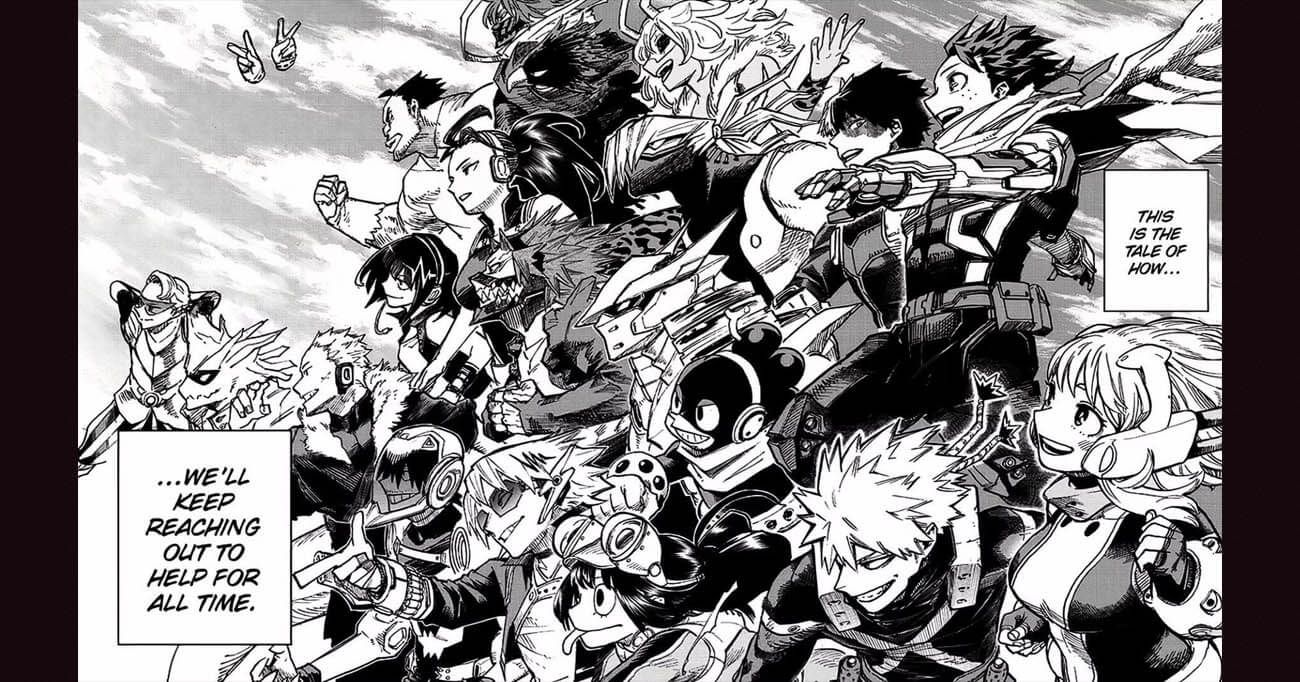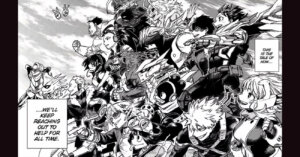This article contains light spoilers for the My Hero Academia manga.
On August 4, 2024 Kohei Horikoshi’s My Hero Academia ended…kind of. The original My Hero Academia: You’re Next film is set to release stateside in October, the seventh season of the anime is airing at the time of writing, and the fandom around the smash hit anime seems bigger than ever based on my own attendance of events like Anime Expo. Nevertheless, a manga that’s graced the pages of the illustrious Shonen Jump since July of 2014 — making it the second longest running series with a regular release schedule in the magazine — has ended and it deserves some reflection.
However, it’s impossible to succinctly capture what made a series this big, and this meaningful to so many, in a single article. My Hero Academia is too influential and touched so many aspects of the rapidly changing anime/manga ecosystem during its ten year run for anyone to neatly sum up everything the manga meant and did in a conventional two to three thousand word write-up. So instead, here are the broad strokes of every major impact, discourse, and development related to My Hero Academia in the past decade.
An Introduction to Anime and Manga for A New Generation
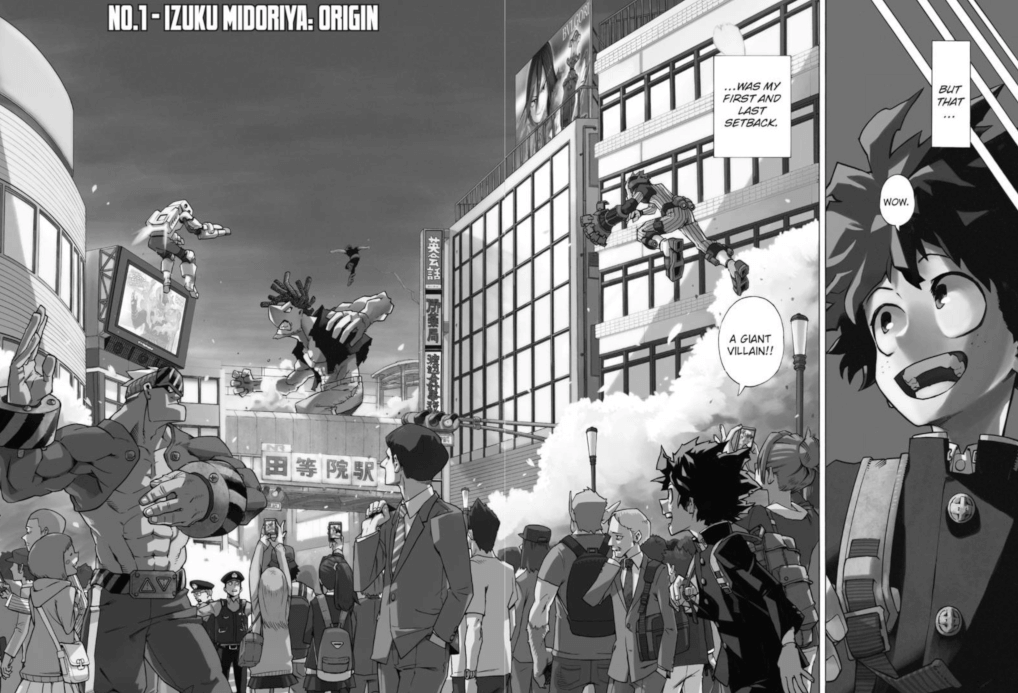
I graduated from a rural Wisconsin high school in 2014, and don’t think I talked to any of my classmates about anything anime related beyond how batshit that first season of Attack on Titan was. It’s not that I wasn’t watching anime or reading manga at the time, it’s just that it wasn’t cool to talk about it and if I tried to, my interest would only be met with hostility or, somehow worse, indifference. You can imagine my surprise when about five years later my Dad, the new coach of my old high school’s golf team, casually mentioned to me on a phone call that kids are showing up to practice wearing My Hero Academia hoodies.
I can’t think of a series that was better prepared to take the world by storm than My Hero Academia was in the mid and late 2010s. The Marvel machine was at peak output when the manga premiered in 2014, and global audiences were desperate for a fresh take on the concept; similar to how Attack on Titan’s early success can be somewhat attributed to its novel interpretation of the zombie media that dominated the early 2010s. Furthermore, MHA’s scholastic setting made it more approachable to fans of works with similar backdrops, like Harry Potter, and allowed the manga to ride the young adult fiction genre’s surge to prominence. Most importantly, all of these elements felt organic to the story that Horikoshi wanted to tell, making the manga feel like it was helping shape this moment in popular culture, rather than try to capitalize on popular trends.
It’s no wonder, then, that My Hero Academia became a household name for even non-anime fans; with its notoriety rivaling other foundational pieces of anime media like Dragon Ball Z and Sailor Moon. At the time of the manga’s conclusion, My Hero Academia is set to be remembered alongside these greats as a new generation of anime and manga fans’ introduction to those mediums. With some top-tier character designs, rock solid world building, and a strong cast of characters that inspire countless amounts of fanart and fiction; young people couldn’t have asked for better series to usher them into this kind of media.
This is set to be My Hero Academia’s most prominent legacy. While it’s superficial to judge media based on its popularity, My Hero Academia accomplished something truly special by becoming a readily accessible gateway into the medium and pushed anime and manga further into global mainstream culture along the way. It won’t be surprising whatsoever if, in a few years, people online argue about what will be “the next My Hero Academia” in the same way people debate about what series make up “the new Big Three” Shonen Jump manga. Once a story gets as big as My Hero Academia has become, it’s forever a part of culture; we’re sure to see it referenced and inspire other works for decades, and it will hold a special place in the hearts of those whose childhoods were shaped by it.
A Series Defined by Decline
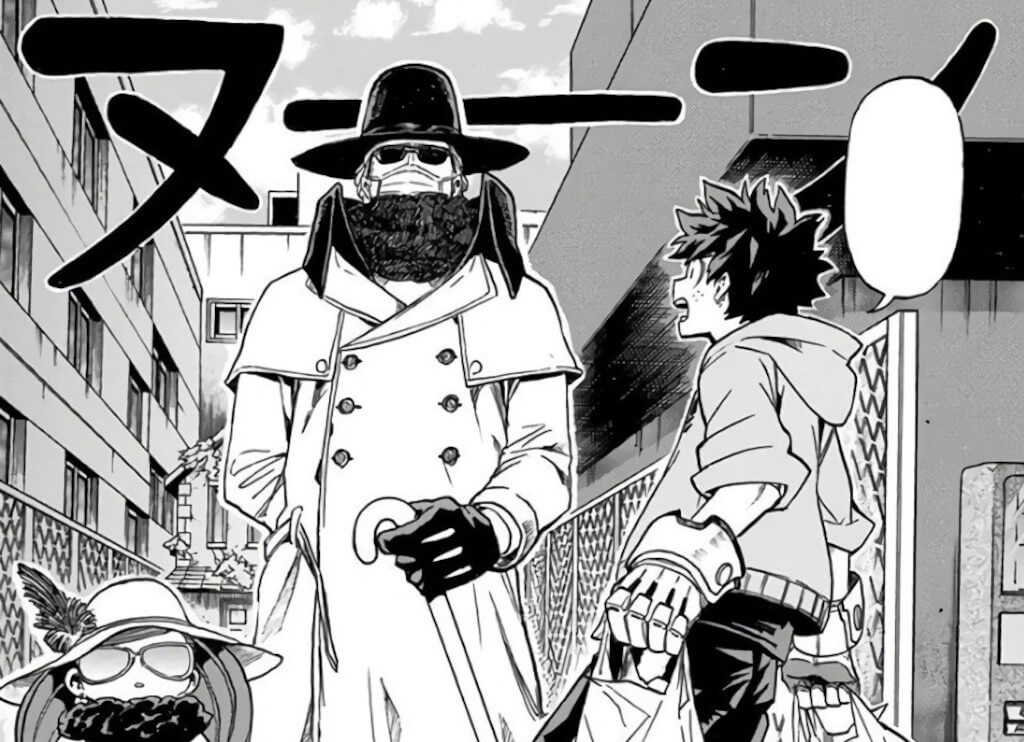
Of course, for as big as My Hero Academia is, much of the critical conversation around it centers on its decline, or where the series “fell off.” From my conversations with more casual anime fans, many think the series took a turn for the worse after the Shie Hassaikai arc. Here, several fan favorite characters got the chance to shine while fighting superpowered members of the Yakuza. However, the following storylines, the Remedial Course arc and the U.A. School Festival arc, were much safer and had an almost slice-of-life tone by comparison. This oscillation between a high-steaks action manga and a novel coming of age story would prove a consistent issue throughout the manga’s run. While supporting works like the School Briefs light novel series and the My Hero Academia: Vigilantes spin-off manga tried to offer more opportunities for readers to experience their favorite elements of the franchise, My Hero Academia never felt like it came together as a cohesive whole.
In my own opinion, much of the narrative and writing issues in the series emerged at the end of the Hero Killer arc. Here, much of the main cast faces off against the villain Stain who is motivated by a desire to purge the world of heroes he thinks are exploiting that title and the privileges that come with it for their own benefit. While Deku and friends emerge victorious, they can’t help but begin to doubt the more capitalistic and commercial elements of hero society.
And then nothing ever comes of that storyline! The social critique that made the early chapters of My Hero Academia so intriguing fall away, and any of these deeper questions are brushed away going forward with the explanation that these young heroes are so plucky and believe in themselves so much, that they couldn’t possibly be in the wrong. Through their idealism of their hero All Might, they strive to be the best versions of themselves and bring the world up with them. This is a really shallow justification for characters who defend the status quo, when prominent antagonists are motivated by social failings like untreated mental illness, queerphobia, a clunky racism metaphor, and the government using heroes to assassinate suspected criminals.
Belief and trying your best cannot fix society’s problems. Ironically, the protagonist Izuku Midoriya knows this better than anyone as someone who was born quirkless in a world where people casually assume a person’s worth based on their superpower. The manga lost its teeth shortly after the Hero Killer arc, and the final product ends up feeling accidentally conservative; where a few big bad apples are responsible for most of the world’s issues and morally infallible super cops are the solution.
I say accidentally conservative, because I don’t think this tone for the series was intended from the start. Instead, I think My Hero Academia started becoming more and more popular in the storylines that followed Stain’s appearance; with the manga becoming much safer as a direct result. This lack of focus in subject matter and clunky politics can be attributed to MHA becoming a phenomenal money maker more than anything else, and the priority shifting from telling a subversive story to keeping fans happy and spending money. It’s ironic, but My Hero Academia’s success seems to be the most responsible for its often discussed decline.
A Turning Point in Anime/Manga Coverage and Fandom
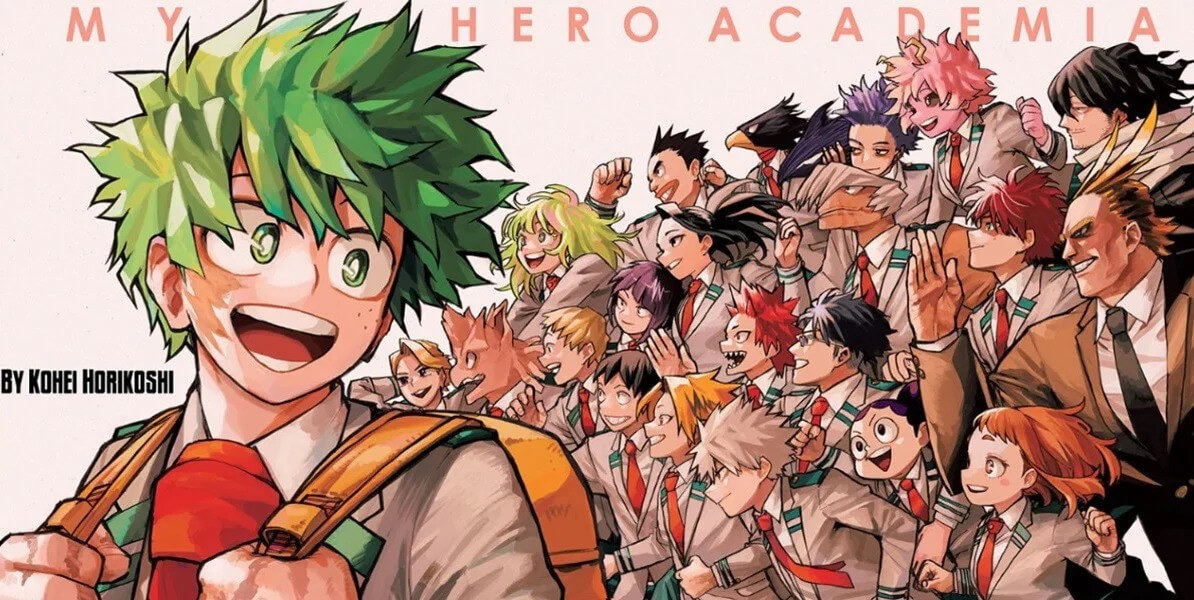
My Hero Academia’s rise also correlated with, and was partially responsible for, a rapid rise in anime and manga coverage in English speaking regions. As you might expect of someone writing a retrospective blog on a recently completed manga, I was a big ol’ dork in high school and read as much as I could about television/film, video games, and anime from various outlets between 2010 and 2014. During this time I noticed a rise in outlets that covered both general entertainment and gaming, but always had to go to sites dedicated to anime for that same level of coverage.
Outlets like IGN, Kotaku, and CBR only gingerly began covering anime around the time I entered college in 2014. Coverage was sparse and mostly stuck to major titles, but it signified anime becoming too globally popular for more mainstream outlets to ignore Then the My Hero Academia anime came out in 2016 and the franchise rapidly became a global hit. Not only did MHA’s western superhero influences and aesthetics make it more approachable to casual audiences in the west, it also gave writers a more familiar framework to work off of in their coverage.
Could outlets justify bringing on anime experts to pad out their editorial staff because of this rise in anime interest? No, but chances are they were already staffed up with people who could cover the massively popular Marvel and DC properties, and those folks definitely had the expertise to write about this superhero flavored hit anime.
Now, with other widely popular anime among young people, like Demon Slayer and Jujutsu Kaisen, set to follow My Hero Academia, it’s likely that the anime would have always found a place in the broader entertainment media landscape. MHA was the anime that convinced a lot of the entertainment press to give the medium a chance, though, so it deserves credit for opening up these spaces. It might seem perfunctory, but this more mainstream coverage thanks to MHA plays a major role in the growth of the anime community, and helped make it a bigger and more diverse space.
A Pillar of the Most Popular Manga Magazine
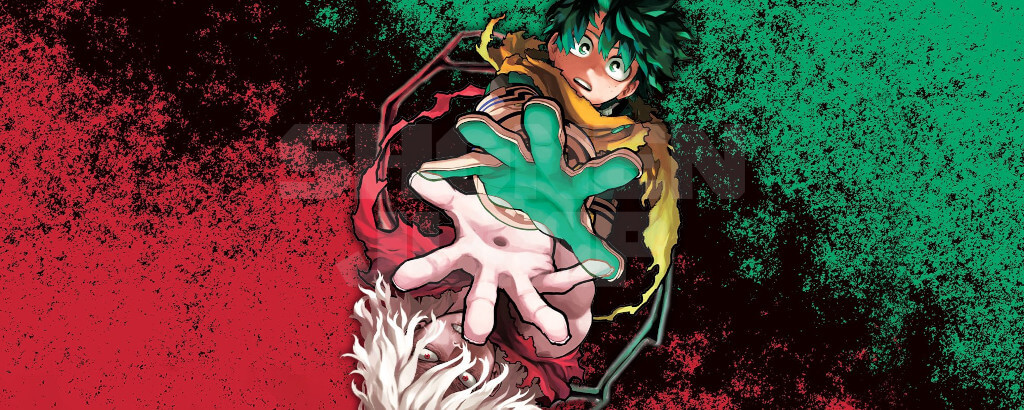
Lastly, it’s hard not to think of My Hero Academia as a major pillar of one of the most popular manga magazines in the past decade. While not the end all be all of the medium, Weekly Shonen Jump is the most well known and successful manga publication, and was instrumental to manga becoming more popular in regions outside of Japan. That’s why many are concerned about how My Hero Academia’s conclusion will affect the magazine and the industry it spearheads.
Despite much fear mongering, the lack of an immediate replacement for My Hero Academia in Shonen Jump doesn’t mean that the publication is in trouble or that manga sales are about to plummet. Sure, Jump leadership probably wants another generational defining hit as much as Jump fanboys do, but time in between those hits is baked into this cycle. Much like television studios don’t expect every new show in their fall lineup to be a hit, it’s normal for a publication like Jump to cycle through various titles of different genres to find something popular that doesn’t cannibalize another of their manga’s existing audience.
This process can take awhile though, and from the outside looking in it can seem like the outlet is floundering. In brief, Shonen Jump has always been aggressive in publishing and cutting new series, often as a part of efforts to find a new series along a specific theme; like a new adventure series or something yokai focused. They don’t expect all of these titles to be successes, as a big part of finding out what does work in an entertainment space is putting resources into finding out what doesn’t work. Just in the same way that television studios will cancel a new show at the end of, or even halfway through, its first season, manga publications drop series that don’t come together in the way that they hope. It just feels more impactful for US readers now because the Shonen Jump App is the first time they’ve been able to see how the manga magazine sausage is made.
Shonen Jump and the broader manga industry existed long before My Hero Academia, and they’re both going to persist now that the manga’s come to a close. While nothing’s ever going to hit quite the same as MHA, it’s effect on the industry will be felt for years to come and, just like its predecessors, it’s sure to inspire rising artists and future series.
A PLUS ULTRA Ending
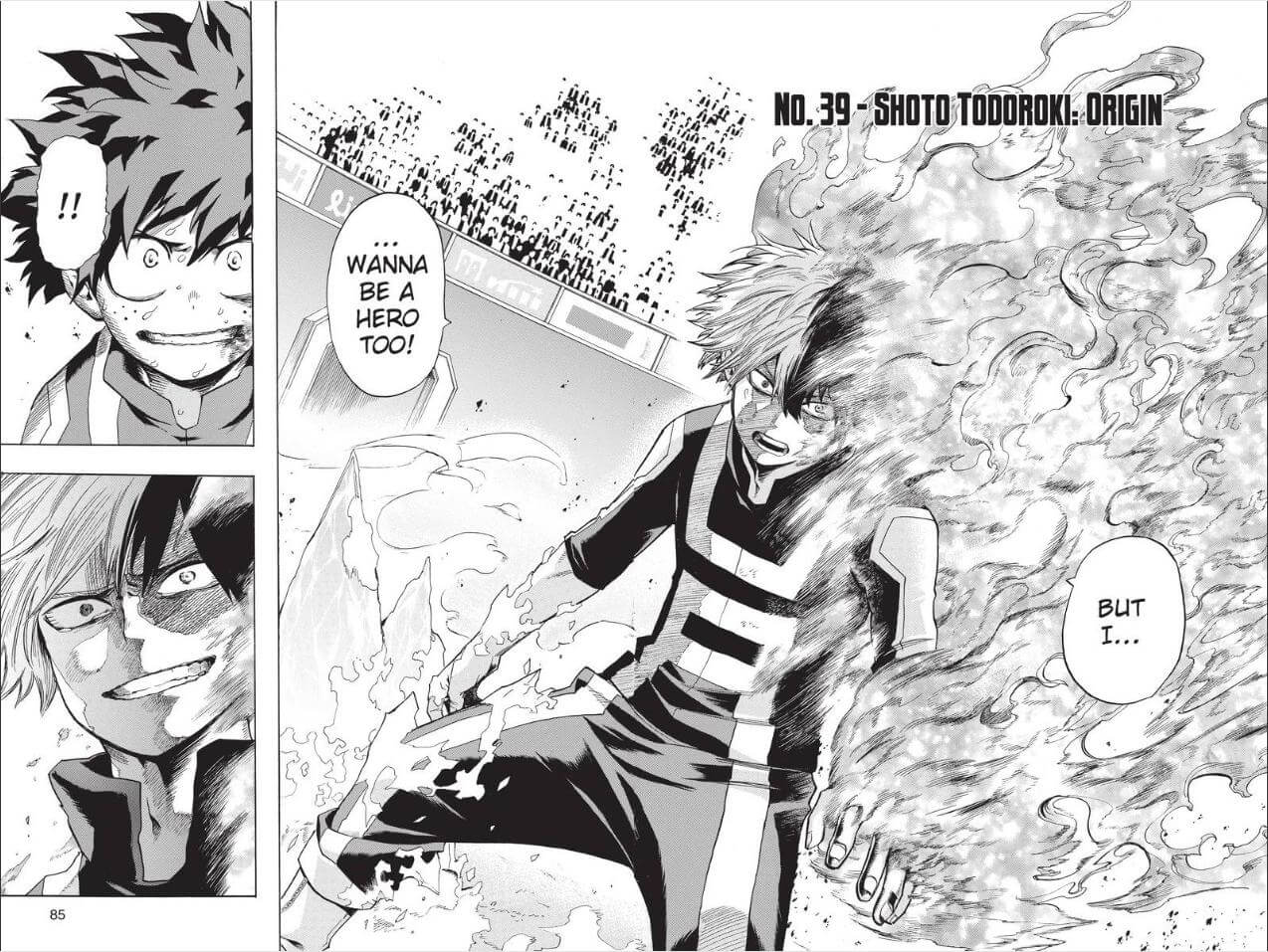
The My Hero Academia manga ran for ten years and meant a whole lot to countless people over the course of, and beyond, its run. It reached a level of global uniquity that makes it feel more like a myth, or an artifact of shared culture, than just a long running comic. For all of its faults and issues, this is a work that changed the world and touched the lives of so many people in it. That’s about all that any artist can aspire to do with their creative work and I hope Horikoshi’s accomplishments are recognized for decades to come.
I’ve done my best to capture the broad strokes of the big facets tied to My Hero Academia ending, but the truth is that we won’t know the full extent of its impact for years. It’s alive as a cultural touchstone and still has an incredible potential to affect the world and the people in it. No other manga is going to be able to do what My Hero Academia did, but future manga will use the ground it laid to hopefully go even further beyond.

Featured Sponsor - JAST
The sweetest romance and the darkest corruption, the biggest titles and the indie darlings; for visual novels and eroge, there's nowhere better.
Big thank you to our supporters
From their continous support, we are able to pay our team for their time and hard work on the site.
We have a Thank-You page dedicated to those who help us continue the work that we’ve been doing.
See our thank you page